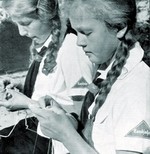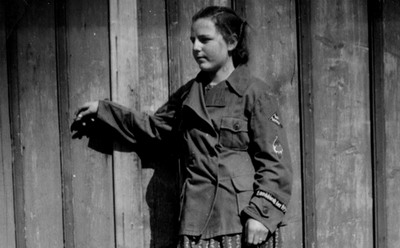 The introductory text in this section is largely reproduced from the book “The Hitler Youth” by David Littlejohn, and all rights remain with the original author and his publisher, Agincourt. We chose to use his text because we probably wouldn’t write it any better.
The introductory text in this section is largely reproduced from the book “The Hitler Youth” by David Littlejohn, and all rights remain with the original author and his publisher, Agincourt. We chose to use his text because we probably wouldn’t write it any better.
The Landjahr (country service year) and Landdienst(country service) of the Hitler Youth were not original concepts at all. Both derived from an earlier nationalist organization, the Bund der Artamenen.
Founded in 1924 by Hans Holfeder as the Bund Artam (the latter word being a coinage from the old Persian by the Anglo-Germanian astrologer William Herschel). Its aim was to furnish voluntary agricultural assistance in Germany’s eastern provinces. The motivation behind this was entirely chauvinistic. As elsewhere in western Europe there had been a steady drift of labor away from the land and into the cities since the turn of the century. In Germany this had meant a movement of population from east to west. To fill the vacuum left by departing Germans, Slav workers had begun to move onto the farms and great estates of East Prussia, Silesia and Saxony. That these migrants could easily become permanent settlers, thus turning the German Grenzland into an extension of Poland, was something that disquieted German nationalists. The Artamenen Movement was created to counter this incursion.
Thanks to its influential supporters, the Bund was not immediately suppressed after Hitler’s accession to power, unlike many other non-Nazi organizations. It was, however, not spared from assimilation.
In 1934 at Gustrow in Mecklenburg it was transformed into the Landdienst der Hitler Jugend, country service of the Hitler Youth. This new branch of the Hitler Youth aimed at sending urban lads for one year to a farm. This, it was hoped, would imbue them with a love of the land and, ideally, induce them to opt for it as a permanent way of life. At this time the Landjahr was not restricted to Hitler Youth members; other young men could, if they wished, also participate. With the gradual absorption of almost the entire youth of Germany into the Hitler Youth, this provision later became meaningless.
The service was voluntary except in the case of university students who were obliged to perform their Landjahr (it was, in reality, only nine months) before being allowed to graduate.
By the end of its first year of existence the Landdienst had forty-five groups with a total of some 500 young men. The following year, 1935, this had risen to 240 groups with over 3,500 members. BDM girls were now included into the service. Expansion of the groups was rapid:
462 in 1936 (with 6,608 members)
1,175 in 1937 (with 14,888 members)
1,452 in 1938 (with 18,000 members)
At the outbreak of war in September 1938 the Landdienst had 26,016 members with girls outnumbering boys. Male volunteers had to be between 14 and 18 years old; females between 14 and 21 years old and had to have the written permission of their parents. They had to submit to a medical examination to assess their fitness for work, which could amount to between fifty-four and sixty hours per week.
They received no pay apart from a nominal 5 Marks per month. The cost of transportation to and from the place of work was borne by the state and living was free, provided by the peasant families with who they were billeted.
No unit was smaller than ten boys or girls. Around 45 to 50 young persons comprised a Landdienstschar, each under a Landdienstscharfuehrer/-in responsible directly to the local HJ-Bannfuehrer or BDM Untergaufuehrerin.
In 1940 the BDM introduced a special Osteinsatz (eastern action), where girls could volunteer to do a minimum of six weeks service in the newly created regions of Wartheland and Danzig-West Prussia in what was pre-war Polish territory. This new service was welcomed by many because even though it was usually between a few weeks and a few months, it counted as a whole year of country service.
Increasingly, “land service in the east” came to mean propaganda work among these new Germans as much as actual toil on the land. The Reich’s new citizens had to be instructed in what being a German meant – even to the extent, in some instances, of being taught the language.
Country Service Year Insignia

The district triangle was unique in that it was green with the word Landjahr in white, like the one seen above. Girls of the League of German Girls also wore the cufftitle, “Landdienst der Hitlerjugend”.
Two other cufftitles that are sometimes seen in photos are for the Landdienst der HJand the BDM-Osteinsatz. The cufftitle for the Landdienst der Hitlerjugend (Country Service of the Hitler Youth) was black with white lettering and was worn by both males and females during their country service year. It was worn on the lower left sleeve of the jacket, as seen in the photos below.

The photo below, which is a detail from a larger image in the webmaster’s collection, shows a girl wearing the cufftitle “Landdienst der HJ” on her left sleeve, as well as a Hitler Youth membership pin on the lapel of her overcoat. The overcoats worn by the girls are similar to the BDM greatcoats with the difference that they have a belt.

After 1940, the BDM Osteinsatz (BDM Work in the East) was introduced and along with it another cufftitle, as seen below. Even though this cufftitle looks like its color is black with white lettering, the actual cufftitle is a dark chocolate brown. It should be noted that Osteinsatz cufftitles were always a dark brown color and did not come in black, blue, or any other colors.

Country Service Year Pamphlet
The following text is a direct translation of a Country Service Year pamphlet that was given to the parents whose children were selected for this service. Since this website pertains only to the BDM, I have left out the clothing and kit list for the male Hitler Youth that was in this pamphlet.
The Country Service Year
The Country Service Year camps are state-run educational facilities. They are under the control of the Reich’s Minister for Science, Education, and Culture.
The Country Service Year is meant to educate specially selected boys and girls to become responsible young Germans who are physically and mentally ready and willing to serve their people in their professions, and in any place where they may be needed. Conscription for Country Service is an honor.
Who is conscripted to the Country Service?
“Participation in the Country Service Year is mandatory for all youths who have finished their minimum educational requirements, and who are conscripted to the County Service.” (Paragraph 1 of the Prussian Country Service Year Law, 29 March 1934). Country Service Year camps are places of strict physical, intellectual, and moral education, not rest homes for frail or only limited suitable youths. Therefore, only those boys and girls are chosen for Country Service, who have proven in school and in their Hitler Youth service that they posses the dependable character, the intellectual abilities, and the physical ability to withstands the rigors of camp life.
Accomodation of the Boys and Girls
On average, 60 Country Service conscripts are quartered in each camp. Country Service camps consist of fixed buildings, former farm houses, and similar structures. The regulations put forth by the Reich’s Ministry of Education assure healthy accommodations, immaculate care, and constant medical supervision. The Country Service Camps fall under the control of the district presidents.
What are the Boys and Girls taught during the Country Service Year?
The educational plan of the Country Service Year includes:
- Physical education
for the boys: premilitary education, athletics, swimming, boxing, etc.
for the girls: gymnastics, athletics, swimming, games, and dance. - Medical service.
- Musical education: singing, musik, theater
- National political education
- Practical and pre-professional education
for the boys: crafts, work at camp, in the garden, on the farm
for the girls: kitchen work, house work, laundry, sewing and mending, child care, farm work
The basis of this versatile education is the age appropriate community life at camp.
The Country Service Year and Parental Homes
Country Service leaders will keep close contact with the parents of the boys and girls at their camp through personal letter exchanges and camp newsletters. Visits from individual parents are discouraged, based on reasons of social justice and with respect to camp life. If possible, an Open Doors event will be held for parents. The boys and girls will not be given vacation during the Country Service Year. Special requests by the parents are to be directed to the district official in whose area the camp is situated.
Career Choice and Vocational Training
Boys and girls who participate in the Country Service Year will start their vocational training later than other youths of the same age. Research shows that this is not a disadvantage. The physical benefits, experience of real comradeship, the discipline and independence needed for careful work, and the readiness to work for the community, are a lasting benefit and help ready them for any choice of career. The varied education during the Country Service often brings out undiscovered talents and gives boys and girls an insight into different careers. Some boys and girls are only able to find their right career choice through the adventures and experiences of their Country Service Year.
Time spent in the Country Service Year counts fully toward an agricultural education or a householding education, which build the basis for any agricultural careers.
The Country Service Year counts as six months of the required Service Year for all girls. Fulfilment of the second six months of the Service Year can be pushed back until after a girl has finished vocational training. Vocational schools, as well as the vocational training in the child care and nursing fields prefer former Country Service Year girls.
The Chamber of Trade, as well as the Chambers of Industry and Commerce, are to pay special attention to former Country Service boys and girls during their career training. Competent Country Service boys and girls who prove themselves in their apprenticeships in trade, industry, or commerce, may be admitted to an early test date for their graduation from apprenticeship. (Shortening of the apprenticeship may be of up to 6 months.)
Great numbers of former Country Service boys have been admitted to aeronautical engineering schools.
In addition, the Country Service Year affords boys and girls who have the proper talent and interest, the following opportunities:
1. for boys: admission to a national political school
2. for boys and girls: admission to a teachers’ college, toward which the Country Service Year counts as education (4 years of training)
3. for boys: admission as a teacher candidate for the Country Service. Training at the National Leadership School – Counry Service, after finishing vocational training. After several years of service as a Country Service Year teacher, possibility to further education to become a school teacher.
4. For girls: admission to the national career education field for Country Service teachers (4 years of training). After several years of service as a Country Service teacher, possibility to further education to become a school teacher.
Conscription for the Country Service Year is done through the head of the Selection Committee of the Country Service, who is posted by the district president.
Selection of the Country Service conscripts is done by the school in collaboration with the Hitler Youth, the public health officer, etc. Further information can be requested from the school principal.
The Country Service Year lasts from April until December with no vacation time.
The Country Service conscripts receive an allowance of 0.05 Reichsmark a day.
Clothing and Equipment to Bring
Girls
1. Required Kit
1 issue BDM blouse, belt, neckerchief, leather knot
2 pairs of sturdy shoes (BDM issue shoes, boots, or ankle boots)
2 pairs of long stockings
3 pairs of socks, including at least 1 pair in white
3 pairs of underwear (preferably separates, undershirt and underpants)
2 underskirts
2 night shifts or pairs of pajamas
2 pairs warm underpants
2 dresses (preferably; must be washable)
1 pair sturdy leather sport shoes, preferably lace-up
1 pair black sweat pants
1 white sport shirt (preferably 2) with HJ insignia
2 aprons (sturdy and large enough to cover clothing)
1 kerchief
2 coat hangers
1 bathing suit and bathing cap
1 Berchtesgaden jacket or other knit jacket
1 rain proof overcoat
1 pair warm gloves
1 garter belt
ample amount of handkerchiefs
writing kit (2 blotters, 1 notebook, 2 pencils, eraser, fountain pen)
sewing kit (black and white thread, darning twill, sewing thread, replacement buttons for clothing and linens, elastic bands, sewing and darning needles, knitting needles, pins, scissors, etc.)
washing and cleaning kit (1 piece soap, 1 tube toothpase, toothbrush, nail brush and cleaner, 1 box shoe creme, 1 pair replacement shoe laces, shoe brush, clothing brush)
2. Requested kit (if owned):
Sweat suit, Jungmaedel uniform, and, if possible, BDM issue skirt and climbing jacket.
Further: if a girl owns a musical instrument (violin, lute, recorder, accordeon) it is to be brought along.
3. Absolutely to be left at home:
Jewelry, purses, etc., unnecessary toiletry articles.
Once at camp, camp clothing will be issued. The camp is responsible for cleaning and care of linens, clothing, shoe repairs, etc.


